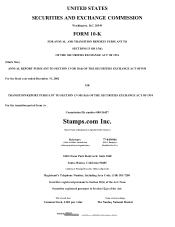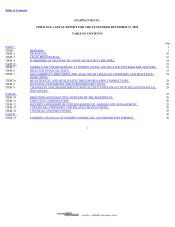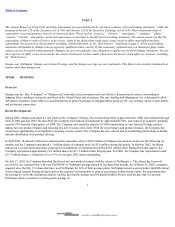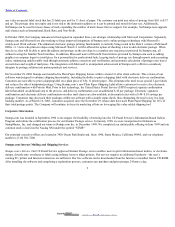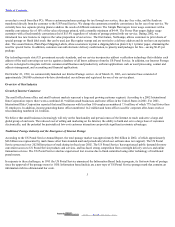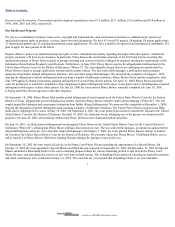Stamps.com 2002 Annual Report Download - page 7
Download and view the complete annual report
Please find page 7 of the 2002 Stamps.com annual report below. You can navigate through the pages in the report by either clicking on the pages listed below, or by using the keyword search tool below to find specific information within the annual report.
Table of Contents
seven days a week from their PCs. When a customer purchases postage for use through our service, they pay face value, and the funds are
transferred directly from the customer to the US Postal Service. We charge the customers a monthly convenience fee for use of our service. We
currently have two separate pricing plans to address the needs of different customers. The Simple Plan targets lower usage customers with a
monthly convenience fee of 10% of the value of postage printed, with a monthly minimum of $4.49. The Power Plan targets higher usage
customers with a fixed monthly convenience fee of $15.99, regardless of volume of postage printed with our service. During 2002, we
introduced two new features to improve the value proposition of our service. The first feature, NetStamps, allows customers to print sheets of
special postage on blank label stock that can be used just like regular stamps and are not tied to a delivery address and do not have an expiration
date. The second feature, Plain Paper Shipping Labels, allows customers to print a shipping label on plain 8 by 11 printer paper, eliminating the
need for special forms. In addition, customers can add electronic delivery confirmation, to priority mail packages for free—saving $0.45 per
package.
Our technology meets strict US government security standards, and our service incorporates address verification technology that validates each
address of the mail sent using our service against a database of all know addresses from the US Postal Service. In addition, our Internet Postage
service is designed to integrate well into common small business and productivity software applications such as word processing, contact and
address management, and accounting and financial applications.
On October 22, 1999, we commercially launched our Internet Postage service. As of March 21, 2003, our customer base consisted of
approximately 290,000 customers who have downloaded our software and registered for one of our service plans.
Overview of Our Industry
Growth of Internet Commerce
The small office/home office and small business markets represent a large and growing customer segment. According to a 2002 International
Data Corporation report, there were a combined 41.9 million small businesses and home offices in the United States in 2001. For 2001,
International Data Corporation reported that small businesses with less than 100 employees numbered 7.8 million, of which 77% had fewer than
10 employees. In addition, income generating home offices numbered 14.2 million and home offices used for corporate after-hours work or
telecommuting numbered 24.1 million.
We believe that small businesses increasingly will rely on the functionality and pervasiveness of the Internet to reach and serve a large and
global group of end users. The reduced cost of selling and marketing on the Internet, the ability to build and serve a large base of customers
electronically, and the potential for personalized low-cost customer interaction can provide significant economic advantages.
Traditional Postage Industry and the Emergence of Internet Postage
According to the US Postal Service Annual Report, the total postage market was approximately $66 billion in 2002, of which approximately
$46 billion was represented by mail classes other than standard mail and periodicals (which our software does not support). The US Postal
Service processed over 202 billion pieces of mail during its fiscal year 2002. The US Postal Service has experienced public demand for more
convenient access to US Postal Service products and services, and has faced strong competition from overnight delivery services and online
transaction services. The US Postal Service also has experienced lost revenue due to fraud committed using older technology of traditional
postal meters.
In response to these challenges, in 1995 the US Postal Service announced the Information Based Indicia program, its first new form of postage
since the approval of the postage meter in 1920. Information based indicia are a new type of US Postal Service postage mark that contains an
information rich two dimensional bar code.
3
2003. EDGAR Online, Inc.


